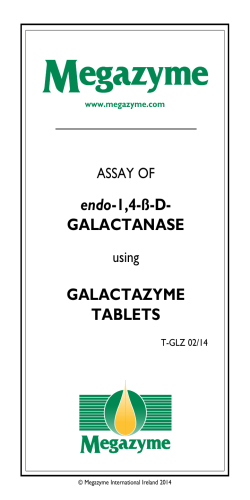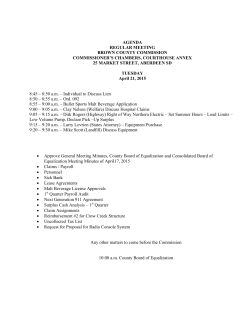
Data Booklet
www.megazyme.com ASSAY OF LIMIT-DEXTRINASE IN CEREAL FLOURS THE LIMIT-DEXTRIZYME METHOD T-LDZ 03/15 © Megazyme International Ireland Limited 2015 SUBSTRATE: The substrate is Azurine-crosslinked-pullulan, which is hydrolysed by limit-dextrinase and pullulanase, but is resistant to attack by other commonly occurring amylolytic enzymes such as α-amylase (cereal and bacterial), α-amylase and amyloglucosidase. The substrate is very slowly hydrolysed (and to a limited extent) by A. niger α-amylase. This enzyme can act at the α-1,4-maltotetraosyl structural units in pullulan. The substrate is prepared by dyeing and crosslinking pullulan polysaccharide to produce a material which hydrates in water, but is water insoluble. Hydrolysis by limit-dextrinase (or pullulanase) produces water soluble dyed fragments and the rate of release of these (increase in absorbance at 590 nm) can be related directly to enzyme activity1 (Figure 1, page 6). The substrate is supplied commercially in a ready-to-use tablet form as Limit-Dextrizyme. ENZYME: 1. Amyloglucosidase (AMG); industrial grade from A. niger containing AMG (2,000 U/mL on soluble starch) and α-amylase (100 U/mL, Ceralpha Method). This enzyme is used in the extraction of limit-dextrinase from malt. These enzymes completely hydrolyse maltose and branched maltodextrins to glucose during the extraction process. The rate of release of soluble dyed fragments on hydrolysis of Limit Dextrizyme tablets by limit-dextrinase is highly activated by maltose2-4 and reduced by the presence of maltodextrins containing (1-6)-α-linkages4 (Figure 2, page 7). BUFFERS: 1. Buffer A: Dilution Buffer Sodium maleate (100 mM, pH 5.5) plus sodium azide (0.02%). Dissolve maleic acid (5.8 g, Sigma Aldrich, cat. no. M0375) in 400 mL of distilled water and adjust the pH to 5.5 with sodium hydroxide solution (2 M) (requires about 35 mL). Add sodium azide (0.1 g). Adjust the volume to 500 mL. Store at room temperature. NOTE: Do not add the sodium azide until the pH is adjusted. Acidification of sodium azide releases a poisonous gas. Sodium azide can be deleted from the buffer if desired, but then the buffer should be stored at 4°C between use. 1 2. Buffer B: Extraction/Activation Buffer Sodium maleate (100 mM, pH 5.5) plus sodium azide (0.02%) plus 25 mM dithiothreitol (for extraction and activation of malt limit-dextrinase). Immediately before use, add 0.1 g of dithiothreitol to 25 mL of Buffer A. NOTE: Dithiothreitol is required for complete extraction and activation of malt limit-dextrinase. Buffer B should be prepared immediately before use. EQUIPMENT (RECOMMENDED): 1. Glass test tubes (16 x 120 mm; 17 mL capacity, round bottomed). 2. Micro-pipettors, 0.5 mL (e.g. Gilson Pipetman®) (for enzyme preparation). 3. Adjustable-volume dispenser (for Tris base solution). 4. Bench centrifuge (required speed 3,000 rpm) or Whatman GF/A glass fibre filter paper. 5. Analytical and top-pan balances. 6. Spectrophotometer set at 590 nm. 7. Vortex mixer (e.g. WiseMix VMIO). 8. Thermostated water bath set at 40°C (e.g. Julabo PC). 9. Stop clock. 10. Whatman No. 1 (9 cm) filter circles and filter funnels. CONTROLS AND PRECAUTIONS: 1. AMG is included in the buffer used to extract limit-dextrinase from malt flour to remove all linear and branched maltodextrins. 2. The time of incubation of the enzyme extract with the LimitDextrizyme must be carefully controlled (i.e. 10 min). 3. Incubation temperatures must be accurately controlled (i.e. 40°C). 4. After addition of Tris base (5 mL) to the reaction tube, the tubes must be stirred vigorously to ensure thorough mixing. 5. Test tablets should be stored dry in well sealed containers at room temperature. 6. The Limit-Dextrizyme assay is affected by the concentration of buffer salts. The optimal buffer salt concentration is 100 mM. 2 ENZYME EXTRACTION FROM CEREAL FLOURS: Mill grain or malt samples to pass a 0.5 mm mesh. Suspend 0.25 g of milled sample in 4.0 mL of Buffer B and add 0.1 mL of AMG solution (Enzyme 1). Extract the sample at 40°C over a period of 5-6 h in sealed tubes. During this time, stir the tubes 4-5 times on a test-tube stirrer and then centrifuge the tubes at 1,800 g (approx. 3,000 rpm) for 10 min. Remove 0.5 mL aliquots for assay directly from the centrifuge tubes. Alternatively, pour off the supernatants, store on ice and assay for activity within the next 2-3 h. ASSAY PROCEDURE: 1. Pre-equilibrate an aliquot (0.5 mL) of flour extract or enzyme solution in a glass test-tube (16 x 120 mm) at 40°C for 5 min. 2. Initiate the reaction by adding a Limit-Dextrizyme tablet without stirring. The tablet rapidly hydrates and disintegrates within 20 seconds. 3. After exactly 10 min, terminate the reaction by adding 5 mL of Tris base solution (1% w/v, pH 11; Megazyme cat. no. B-TRIS500) with vigorous stirring on a vortex mixer. Leave the tubes at room temperature. 4. After approx. 5 min stir the slurry again and then filter through a Whatman No. 1 (9 cm) filter circle. 5. Measure the absorbance of the filtrate against a reaction blank at 590 nm. 3 NOTES: 1. Prepare a substrate/enzyme blank by adding Tris base to the enzyme solution before the addition of the Limit-Dextrizyme tablet. A single blank is required for each set of determinations. The absorbance of this blank and of the reaction solutions are measured at 590 nm against distilled water. The blank absorbance value is subtracted from the reaction values before reference to the standard curve. 2. After addition of Tris base, tubes should be stored at room temperature, and the slurry should be filtered within 30 min. The dye-carbohydrate covalent linkage is slowly cleaved under alkaline conditions at elevated temperatures. STANDARDISATION: A standard curve relating the activity of pure barley malt limitdextrinase on borohydride reduced pullulan and on Limit-Dextrizyme tablets (Lot 121102) is shown in Figure 1, page 6. The curve varies with different lots of tablets. Please ensure that the Limit-Dextrizyme lot numbers on the Standard Curves and the Tablet Pack are the same. Activity on borohydride reduced pullulan was determined at a substrate concentration of 5 mg/mL in 100 mM maleate buffer (pH 5.5) at 40°C using the Nelson/Somogyi reducing sugar procedure. One Unit of activity is defined as the amount of enzyme required to release one μmole of glucose reducing-sugar equivalents per minute from pullulan under the defined assay conditions. The standard curve relating limit-dextrinase activity to absorbance (590 nm) is not linear. The effect of maltose and maltotriosyl-α-(1,6)-maltotriose on the rate of release of dyed fragments on hydrolysis of AZCL-pullulan (the active in Limit Dextrizyme tablets) is shown in Figure 2, page 7. Clearly, maltose gives a substantial increased release of soluble, dyed fragments and this is considered to be due to the transglycosylation properties of the enzyme3. This effect is removed by hydrolysing the maltose to glucose with excess levels of AMG4. In contrast, the hexasaccharide, maltotriosyl-α-(1,6)-maltotriose, significantly reduces the rate of release of soluble, dyed fragments on hydrolysis of AZCLpullulan. In this case, the oligosaccharide is acting as a competitive substrate. Again, this effect can be removed by pre-incubation the oligosaccharide with AMG to catalyse complete hydrolysis to glucose. Thus, to obtain an accurate measure of limit-dextrinase in malt flour, AMG must be included in the buffer used to extract the enzyme from the flour sample. 4 CALCULATION OF ACTIVITY: Malt limit-dextrinase activity is determined by reference to the standard curve to convert absorbance values to mU of limitdextrinase activity per assay, and then calculated as follows: Units/kg Malt 1 = milli-Units per assay (i.e. per 0.5 mL) x x 32,800 1000 where: 1 1000 = conversion from mU to Units 32,800 = conversion from activity per 0.5 mL of extract to that in 1 kg of malt. - 0.25 g of flour is extracted with 4.0 mL of buffer plus 0.1 mL of AMG (i.e. 4.1 mL/0.25 g of flour). - 0.5 mL of enzyme is used per assay. Figure 1. Pure malt limit-dextrinase standard curve on Limit- Dextrizyme Tablets (Lot 121102). 5 Figure 2. The effect of maltose and on the rate of release of dyed fragments on hydrolysis of Limit Dextrizyme tablets by pure malt limit-dextrinase. Limit dextrinase (0-26 mU/0.5 mL) plus: A. Maleate buffer only. B. Maltose (40 mg/mL) in maleate buffer. C. Maltose (40 mg/mL) plus AMG (80 U), pre-incubated for 15 min. D. Maltotriosyl-α-(1,6)-maltotriose(40 mg/mL) in maleate buffer. E. Maltotriosyl-α-(1,6)-maltotriose(40 mg/mL) plus AMG (80 U) in maleate buffer. Experimental Conditions: Limit-dextrinase (0.2 mL, 0-26 mU) was added to a glass test tube (16 x 120 mm) together with; (A) 0.3 mL of buffer; (B) 0.1 mL of buffer plus 0.2 mL of maltose (100 mg/mL) in buffer; (C) 0.1 mL of AMG (800 U/mL) plus 0.2 mL of maltose (100 mg/mL) in buffer; (D) 0.1 mL of buffer plus 0.2 mL of maltotriosylα-(1,6)-maltotriose (100 mg/mL) in buffer; (E) 0.1 mL of AMG (800 U/mL) plus 0.2 mL of maltotriosyl-α-(1,6)-maltotriose (100 mg/ mL). Also, (F) 0.1 mL of AMG (800 U/mL) in buffer plus 0.4 mL of buffer was included to check for any activity of the AMG (containing α-amylase) on the Limit Dextrizyme substrate. 6 Recently, a new procedure for the measurement of pullulanase and limit-dextrinase has been published4,5. In this procedure, the substrate is 4,6-O-benzylidene-2-chloro-4-nitrophenyl-β-63-α-Dmaltotriosyl-maltotriose (BzCNPG3G3). Pullulanase or limitdextrinase cleaves the 1,6-α-linkage releasing 2-chloro-4-nitrophenylβ-D-maltotriosyl-maltotriose, which is immediately hydrolysed to glucose and free 2-chloro-4-nitrophenol by the excess quantities of both α-glucosidase and β-glucosidase present in the reagent mixture. The reaction is terminated and colour developed by adding an alkaline solution. One Unit of activity is referred to as a “PULLG6” Unit. For pure barley malt limit-dextrinase: 1 PULLG6 Unit = 3 Units of activity on BH4 reduced pullulan. REFERENCES: 1. McCleary, B. V. (1992). Measurement of the content of limitdextrinase in cereal flours. Carbohydrate Research, 227, 257-268. 2. MacGregor, A. W., Bazin, S. L. & Schroeder, S. W. (2002). Effect of starch hydrolysis products on the determination of LD and LD inhibitors in barley and malt. J. Cereal Sci., 35, 17-28. 3. McDougall, G. J., Ross, H. A., Swanston, J. S. & Davies, H. V. (2004). LD from germinating barley has endo-transglycosylase activity, which explains its activation by maltodextrins. Planta, 218, 542-551. 4. Mangan, D., McCleary, B. V, Cornaggia, C., Ivory, R., Rooney, E. & McKie, V. (2015). Colourimetric and fluorimetric substrates for the assay of limit-dextrinase. J. Cereal Sci., 62, 50-57. 5. McCleary, B. V. Mangan, D., McKie, V., Cornaggia, C., Ivory, R. & Rooney, E. (2014). Colourimetric and fluorometric substrates for measurement of pullulanase activity. Carbohydrate Research, 393, 60-69. 7 NOTES: 88 NOTES: 99 NOTES: 10 Megazyme International Ireland, Bray Business Park, Bray, Co. Wicklow, IRELAND Telephone: (353.1) 286 1220 Facsimile: (353.1) 286 1264 Internet: www.megazyme.com E-Mail: info@megazyme.com WITHOUT GUARANTEE The information contained in this booklet is, to the best of our knowledge, true and accurate, but since the conditions of use are beyond our control, no warranty is given or is implied in respect of any recommendation or suggestions which may be made or that any use will not infringe any patents. 11
© Copyright 2025












